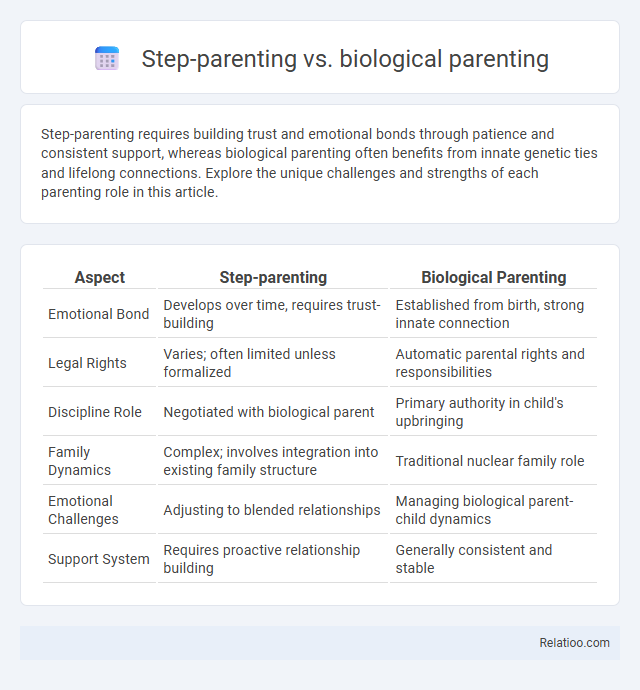Step-parenting requires building trust and emotional bonds through patience and consistent support, whereas biological parenting often benefits from innate genetic ties and lifelong connections. Explore the unique challenges and strengths of each parenting role in this article.
Table of Comparison
| Aspect | Step-parenting | Biological Parenting |
|---|---|---|
| Emotional Bond | Develops over time, requires trust-building | Established from birth, strong innate connection |
| Legal Rights | Varies; often limited unless formalized | Automatic parental rights and responsibilities |
| Discipline Role | Negotiated with biological parent | Primary authority in child's upbringing |
| Family Dynamics | Complex; involves integration into existing family structure | Traditional nuclear family role |
| Emotional Challenges | Adjusting to blended relationships | Managing biological parent-child dynamics |
| Support System | Requires proactive relationship building | Generally consistent and stable |
Introduction to Step-Parenting and Biological Parenting
Step-parenting involves forming new family dynamics where a non-biological parent assumes caregiving roles, often requiring emotional adjustment to blend with existing family structures. Biological parenting centers on the genetic connection and shared history between parent and child, influencing attachment and development patterns. Your understanding of these distinctions is crucial, especially when navigating potential challenges like adjustment disorder, which can arise from complex family transitions.
Defining the Roles: Step-Parent vs Biological Parent
Step-parenting involves navigating the complex role of providing support, discipline, and emotional connection without the biological bond that shapes traditional parenting dynamics. Biological parents carry inherent responsibilities tied to genetics and legal rights, often influencing the child's identity formation and attachment security. Your ability to adapt and establish clear boundaries within these roles plays a crucial role in mitigating adjustment disorder symptoms in children during family transitions.
Emotional Bonds: Building Trust and Connection
Emotional bonds in step-parenting often require deliberate efforts to build trust and connection, as these relationships lack the inherent biological ties present in biological parenting. You must foster open communication, consistent support, and patience to help children overcome feelings of Adjustment Disorder, which can arise from family transitions and affect emotional stability. Strong, empathetic interactions between step-parents and children significantly enhance trust and create a secure environment vital for healthy emotional development.
Legal Rights and Responsibilities
Step-parenting, biological parenting, and adjustment disorder each present distinct challenges in legal rights and responsibilities. Biological parents hold inherent legal rights and duties, including custody and child support obligations, while step-parents often require formal adoption or guardianship to gain similar rights. Your understanding of how adjustment disorder impacts a child's well-being can influence custody decisions and mandates related to mental health support in family law cases.
Navigating Family Dynamics and Relationships
Navigating family dynamics in step-parenting requires understanding distinct emotional challenges compared to biological parenting, where genetic bonds naturally influence attachment and authority. Adjustment disorder often emerges in blended families due to role ambiguity, shifting loyalties, and changes in household routines. Effective communication, consistent boundaries, and empathy serve as critical tools for fostering healthy relationships and minimizing emotional stress in both step-parent and biological parent roles.
Challenges Unique to Step-Parenting
Step-parenting presents unique challenges distinct from biological parenting, including navigating complex family dynamics, building trust with stepchildren, and establishing boundaries without the innate parental authority. Your role often requires balancing respect for the biological parent's influence while fostering a supportive and stable environment, which can be emotionally taxing. These challenges may contribute to adjustment disorders in both stepparents and stepchildren as they adapt to new family structures and evolving relationships.
Discipline and Authority: Balancing Roles
Balancing discipline and authority in step-parenting versus biological parenting requires understanding the unique dynamics each role presents, as step-parents must navigate establishing respect without biological bonds while biological parents often have ingrained authority. Your approach needs to foster open communication and consistency to prevent adjustment disorders in children struggling with role confusion and changing family structures. Effective discipline balances empathy with clear boundaries, enabling both step-parents and biological parents to maintain harmony and emotional stability within blended families.
Communication Strategies for Blended Families
Effective communication strategies in blended families address the unique challenges faced by step-parents and biological parents to foster trust and understanding. Establishing clear, consistent boundaries combined with active listening helps mitigate conflicts arising from adjustment disorders often experienced by children navigating new family dynamics. Collaborative problem-solving and regular family meetings create safe spaces for expressing emotions and reinforcing family cohesion, enhancing overall psychological adjustment.
Supporting Children Through Transition
Supporting children through the transition between biological parenting and step-parenting requires tailored strategies to address emotional challenges and foster secure attachments. Consistent communication, validation of the child's feelings, and establishing clear routines help mitigate the risk of adjustment disorder during family restructuring. Engagement in therapeutic interventions promotes resilience, aiding children in navigating identity shifts and emotional complexities inherent in blended family dynamics.
Long-Term Outcomes: Success Stories and Lessons Learned
Long-term outcomes in step-parenting compared to biological parenting reveal diverse success stories, highlighting resilience and adaptability in blended families. Research shows that step-children with supportive step-parents often develop strong emotional bonds, contributing to improved mental health and reduced risk of adjustment disorder. Your commitment to open communication and consistent support fosters positive relational dynamics, ultimately promoting healthier psychological adjustment and family stability.

Infographic: Step-parenting vs Biological parenting
 relatioo.com
relatioo.com